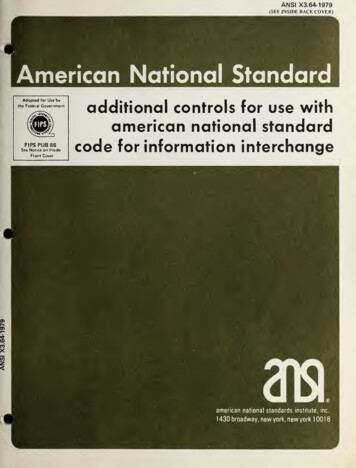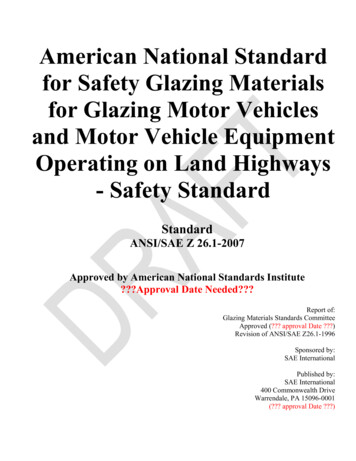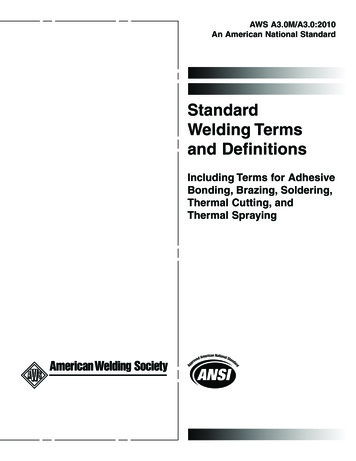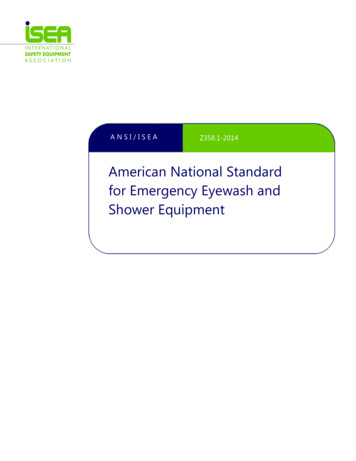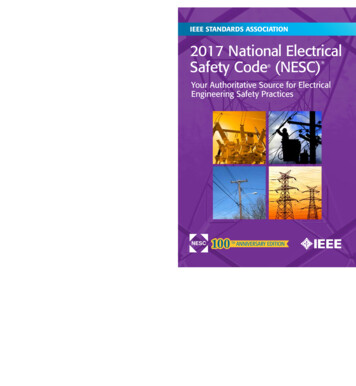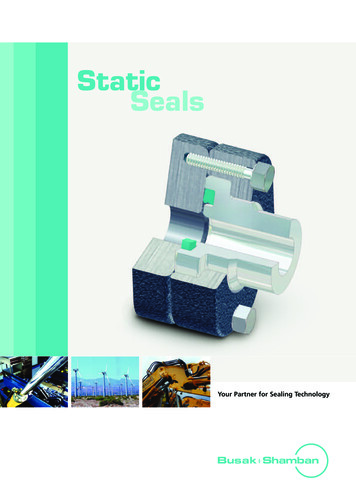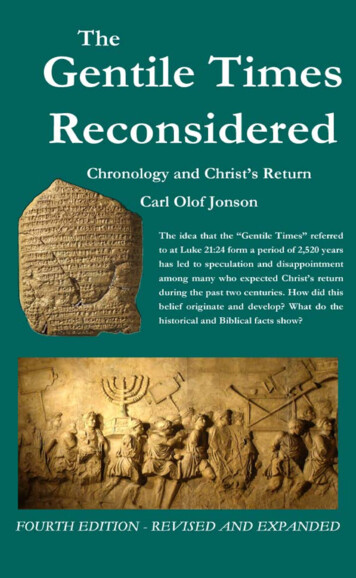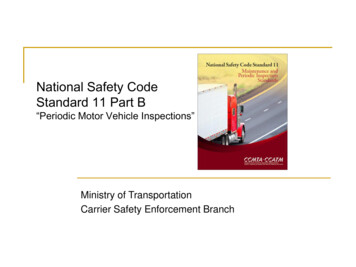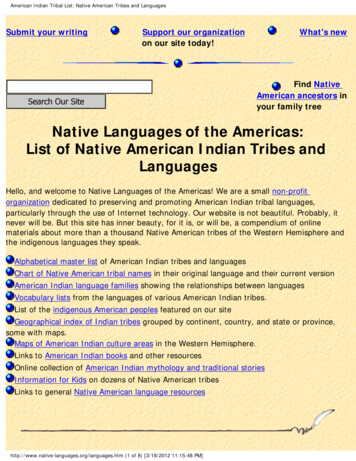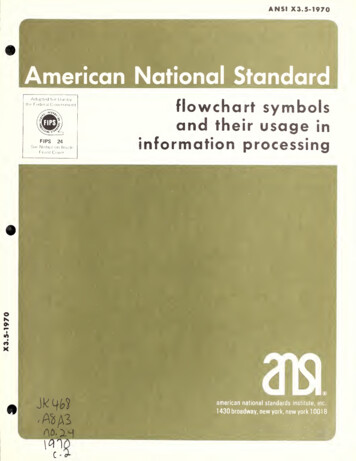
Transcription
ANSI X3.5-1970r1American National Standard‘' ';-' A.v'„"Adopted for Use byflowchart symbolsand their usage ininformation processingthe Federal Government(mm)\ '*tS'** Z FIPS24X3.5-1970See Notice on InsideFront CoverT\' V". ' t'e'V-VA . ansiamerican national standards institute, inc. 1430 broadway, new york, new york 10018,AO.
This standard was approved as a Federal Information Processing Standard by theOffice of Management and Budget on March 19, 1973.Details concerning the use of this standard within the Federal Government arecontained in FIPS PUB 24, FLOWCHART SYMBOLS AND THEIR USAGE ININFORMATION PROCESSING. For a complete list of the publications availablein the FEDERAL INFORMATION PROCESSING STANDARDS Series, write tothe Office of Technical Information and Publications, National Bureau of Standards,Washington, D.C. 20234.
ViQootf Mss * ? St&aM#DEC7 TOANSIJK MUX3.5-1970A % fiiRevision ofUSA StandardX3.5-1968American National StandardFlowchart Symbols and Their Usage inInformation ProcessingSponsorBusiness Equipment Manufacturers AssociationApproved September 1, 1970American National Standards Institute, Inc
American National StandardAn American National Standard implies a consensus of those sub stantially concerned with its scope and provisions. An American NationalStandard is intended as a guide to aid the manufacturer, the consumer,and the general public. The existence of an American National Standarddoes not in any respect preclude anyone, whether he has approved thestandard or not, from manufacturing, marketing, purchasing, or usingproducts, processes, or procedures not conforming to the standard.American National Standards are subject to periodic review and usersare cautioned to obtain the latest editions.CAUTIONNOTICE: ThisAmericanNationalStandardmayberevised or withdrawn at any time. The procedures of the AmericanNational Standards Institute require that action be taken to reaffirm,revise, or withdraw this standard no later than five years from thedate of publication. Purchasers of American National Standards mayreceive current information on all standards by calling or writing theAmerican National Standards Institute.The symbols contained in this standard may be copied, reproduced,or employed in any fashion without permission of the StandardsInstitute. Any statement that the symbols used are in conformancewith this American National Standard shall be on the user’s ownresponsibility.Published byAmerican National Standards Institute, Inc1430 Broadway, New York, New York 10018Copyright 1971 by American National Standards Institute, IncorporatedAll rights reserved.No part of this publication may be reproduced in any form,in an electronic retrieval system or otherwise,without the prior written permission of the publisher.Printed in the United States of America
Foreword(This Foreword is not a part of American National Standard Flowchart Symbols and Their Usage in Information Pro cessing, X3.5-1970.)The purpose of a flowchart is to improve man-to-man communication relative to the descriptionand analysis of an information processing problem. Flowcharting is a technique in which symbolsrepresent both the sequence of operations and the flow of data and paperwork.The use of flowcharts became widespread in the field of information processing concurrent withthe application of electronic computers to problems of business and industry. Occasionally, how ever, the interpretation of a flowchart resulted in misunderstanding. One source of misunderstand ing stemmed from a lack of uniformity of meaning for specific symbols in the flowcharts.The historical development of flowchart symbols has many facets. Initially, groups of individualsin a company coordinated their work on flowcharting. Later, this same need for a uniform set ofsymbols became apparent to larger groups of persons who exchanged flowcharts, for example,government, commercial and industrial user groups, equipment manufacturers, form suppliers,professional societies, and consultants. Eventually, as each group attempted to establish a uniformset of symbols for its own members, the need for an American National Standard for flowchartsymbols was recognized.The American National Standards Committee on Computers and Information Processing, X3,delegated to the Subcommittee on Problem Definition and Analysis, X3-6, the responsibility forpreparing a standard for flowchart symbols and their usage. In meeting this obligation, the X3-6Subcommittee:(1) Identified and analyzed the information processing functions to be flowcharted.(2) Obtained and studied sets of symbols from organizations.(3) Performed a statistical study on the definitions and the symbols representing those functions.(4) Obtained copies of flowcharting conventions from contributing organizations.(5) Analyzed the material received to determine the types of conventions used and the extent towhich these conventions find common application.(6) Circulated the results to a representative audience for comment.(7) Developed and recommended a standard for flowchart symbols and their usage for informa tion processing problem definition.American National Standard X3.5-1970 is an expansion of X3.5-1968, which was itself arevision of a 1966 standard on the subject. The symbol shapes contained in X3.5-1968 areunchanged; however, several definitions and names have been modified slightly so that theyconform exactly to Flowchart Symbols for Information Processing, ISO RecommendationR 1028-1969 (Geneva: International Organization for Standardization, March 1969, 1st edition).In addition to several clarifying remarks that have been added, this standard containsthirteen additional symbols and their definitions.Suggestions for improvement gained in the use of this standard will be welcome. They should besent to the American National Standards Institute, 1430 Broadway, New York, N.Y. 10018.At the time it approved this standard, the X3 Committee had the following members:Charles A. Phillips, ChairmanAlexander C. Grove, Secretaryj-Organization RepresentedName of RepresentativeAdministrative Management SocietyC. S.Air Transport AssociationAmerican Bankers AssociationAmerican Gas AssociationAmerican Institute of Certified Public AccountantsAmerican Library AssociationAmerican National Standards Committee on Office Machines, X4 (Liaison)American Newspaper Publishers AssociationAmerican Petroleum InstituteAmerican Society of Mechanical Engineerst Deceased.EverhardtFrank C. WhiteJohn C. HouhoulisJoseph A. PinnolaNoel ZakinDavid L. WeisbrodC.E. GinderfW. D. RinehartF. A. GitzendannerGeorgeC.Finster
Organization RepresentedName of RepresentativeAssociation of American RailroadsR. A. PetrashJohn A. N. LeeJ. J. Fast, JrLarry AvanzinoR. W. BernerT. H. BonnA. C. BrownStanley BucklandD. J. DaughertyU. S. C. DilksStanley ErdreichR. W. GreenW. S. HumphreyR. J. LaMannaR. J. MindlinGlen PoorteDonald J. ReyenDonald MacPhersonH. D. LimmerHoward H. SmithDelbert ShoemakerWilliam BregartnerCharles L. HutchinsonG. W. PattersonTheodore WieseEdwin L. LuippoldJ. O. HarrisonArnold F. GriswoldEthel LangtryLawrence ChvanyH. T. HoffmanE. TomeskiV. N. Vaughan, JrRobert A. RaupAssociation for Computing MachineryAssociation for Educational Data SystemsBusiness Equipment Manufacturers AssociationData Processing Management AssociationEdison Electric InstituteElectronic Industries AssociationGeneral Services AdministrationInsurance Accounting and Statistical AssociationInternational Communications AssociationInstitute of Electrical and Electronics EngineersJoint Users GroupLife Office Management AssociationNational Bureau of StandardsNational Machine Tool Builders AssociationNational Retail Merchants AssociationPrinting Industries of AmericaScientific Apparatus Makers AssociationSystem and Procedures AssociationTelephone GroupU.S. Department of DefenseThe members of the Subcommittee on Problem Definition and Analysis, X3-6, which was respon sible for the development of this revision, were as follows:C. D. Christensen, ChairmanW. L. BryanJ. R. CrawfordJ. N. RidgellL. W. SmithM. GremsF. D. Heiss, JrM. F. HillC. R. ShochJ. G. SolomonR. StrausbergW. B. SwiftC. J. LyonsD. MaceC.K. VanderhoofR. P. WenigH D. Mayo IllC. T. MeadowJ. F. WoodW. D. MorganW. C. WorrellJ. W. YoungOthers who contributed:R. H. AllenR. E. BidigareN. BrownP. BrownP. G. CharestC. ChronisW. CoreyJ. L. DonaldsonJ. W. DreschD. DrusdowW. DunskyM. FordH. GammonD. PriggeR. GreenA. HassanJ. W. PurvisR. A. RaupM. HawesJ. E. HeskinR. HutchinsonE. KerksieckR. F. RodgersR. J. RossheimJ. MaroneyM. MichicheD. J. NailorJ. E. O’Hara, JrR.G. PeacockJ. PfaffW. RobergsJ. E. SeeleyS. R.ShugarA. StrasserO. TidwellR. E. UtmanJ. Wood
ContentsSECTIONP AO E1. Purpose and Scope1.1 Purpose .1.2 Scope . 2. Definitions . 3. Flowchart Symbols3.1 Symbols Represent Functions883.2 Basic Symbols .3.2.1 Input/Output Symbol*83.2.2 Process Symbol3.2.3 Flowline Symbol3.2.3.1Crossing of Flowlines.3.2.3.2 Junction of Flowlines3.2.4 Comment, Annotation Symbol889993.3 Specialized Symbols3.3.1 In put/Out put Symbols3.3.1.1Punched Card Symbol3.3.1.1.1 Specialized Punched Card .3.1.83.3.1.9Online Storage SymbolMagnetic Tape SymbolPunched Tape SymbolMagnetic Drum SymbolMagnetic Disk SymbolCore SymbolDocument SymbolManual Input Symbol3.3.1.10 Display Symbol3.3.1.11 Communication Link Symbol3.3.1.12 Offline Storage Symbol3.3.2 Specialized Process Symbols3.3.2.1Decision Symbol3.3.2.2Predefined Process Symbol3.3.2.3Preparation Symbol3.3.2.4Manual Operation Symbol3.3.2.5 Auxiliary Operation Symbol3.3.2.6Merge Symbol3.3.2.7Extract Symbol3.3.2.8 Sort Symbol3.3.2.9 Collate Symbol3.4 Additional Symbols3.4.1 Connector Symbol3.4.2 Terminal, Interrupt Symbol3.4.3 Parallel Mode Symbol99999101010101010101010101010111111111 1111111I 11112121. Symbol Csein Flowcharting.1.1 Symbol .Shape .4.2 Symbol Size4.3 Symbol Orientation4.4 Flow Direction12121212121.4.1 Flowline .4.4.2 Communication Link1212
PAGESECTION4.54.6Flowchart TextSymbol Identification124.74.8Symbol Cross ReferenceConnector Referencing.4.8.1Connector Common Identification .1313134.8.2Cross Referencing Connectors.Symbol Striping .4.9.1Striped Symbol .4.9.2First Symbol of Detailed Representation131313134.9.3Cross Referencing of Striped Symbol and Detailed Representation134.10 Multiple Exits .4.10.1 Symbol Exits4.10.2 Multiple Logic Paths .1313144.94.11Branching Table .4.12 Repetitive Representation of the Same Media4.12.1 Multiple Symbols.1414144.12.2 Overlay Pattern4.12.3 Priority Representation14144.12.4 Flowlines with Repetitive Symbols .145. Summary of Flowchart Symbols.15Appendix. International Considerations.17
American National StandardFlowchart Symbols and Their Usage inInformation Processingconnector. A means of representing on a flow 1. Purpose and Scopechart a break in a line of flow,1.1 Purpose. The purpose of this standard isto establish flowchart symbols and their usagein the preparation of flowcharts for informa tion processing systems, including automaticdata processing systems.data. Any representations such as characters1.2 Scope. This standard prescribes and de document. (1) A medium and the data recordedfines flowchart symbols to represent the se quence of operations, the flow of data, and theflow of paperwork on flowcharts for informa tion processing; prescribes presentation tech niques for flowchart symbols on flowcharts;and prescribes and defines the use of flowchartsymbols for the following: flowchart text, sym bol identification, symbol cross reference, con nector referencing, symbol striping, multipleon it for human use, for example, a reportsheet, a book. (2) By extension, any recordthat has permanence and that can be read byman or machine.or analog quantities to which meaning is ormight be assigned.decision. A determination of a future action,display. A visual presentation of data.flowchart. A graphical representation of thedefinition, analysis, or solution of a problemin which symbols are used to represent opera tions, data, flow, equipment, and so forth.flowchart text. The descriptive informationexits, branching table, and repetitive repre sentation of the same media.that is associated with flowchart symbols.flow direction function. The function of link This standard does not cover pictorial-typeflowcharts that utilize pictures or drawings toing symbols. The indicating of the sequence ofavailable information and executable opera tions.depict a system.flowline. On a flowchart, a line representing2. Definitionsa connecting path between flowchart symbols;a line to indicate a transfer of data or control,analysis. The methodical investigation of afunction. A specific purpose of an entity or itsproblem, and the separation of the probleminto smaller related units for further detailedstudy.characteristic action.inconnector. A connector that indicates a con annotation. An added descriptive commenttinuation of a broken flowline.or explanatory note.information. Theauxiliary operation. An offline operation per assigns to data by means of the known con ventions used in its representation.formed by equipment not under control of thecentral processing unit.meaningthatahumaninformation processing. The execution of asystematic sequence of operations performedupon data.bidirectional flow. In flowcharting, flow thatcan be extended over the same flowline ineither direction.input/output function. The making availablethat includes the circuits controlling the inter pretation and execution of instructions,of information for processing (input) or therecording of the processed information (out put).communication link. The physical means ofI/O.central processing unit. A unit of a computerAn abbreviation for input/output.(Seeinput/output function.)connecting one location to another for thepurpose of transmitting and receiving informa tion.magnetic tape. (1) A tape with a magnetic sur face on which data can be stored by selective7
X3.5AMERICAN NATIONAL STANDARD FLOWCHART SYMBOLSpolarization of portions of the surface. (2) Atape of magnetic material used as the constitu ent in some forms of magnetic cores.system. An organized collection of men, ma manual input. (1) The entry of data by handterminal. A point in a system or communica into a device at the time of processing. (2) Thedata entered as in (1).tion network at which information can eitherenter or leave.medium. The material or configuration there of on which data is recorded; for example,paper tape, cards, magnetic tape,chines, and methods required to accomplisha specific objective.transmit. To send data from one location andto receive the data at another location.normal direction flow. A flow in a directionfrom left to right or top to bottom on a flow 3. Flowchart Symbolschart.offline storage.Storagenotunder controlof the central processing unit,online storage. Storage under control of thecentral processing unit.operation. The event or specific action per formed by a logic element,oufconnector. A connector that indicates apoint at which a flowline is broken for a con tinuation at another point.problem definition. A term associated withboth the statement and solution phase of aproblem and used to denote the transforma tions of data and the relationship of pro cedures, data, constraints, environments, andso forth.process function. The process of executing a3.1 Symbols Represent Functions.Symbolsare used on a flowchart to represent the func tions of an information processing system.These functions are input/output, processing,flow direction, and annotation.A basic symbol is established for each func tion and can always be used to represent thatfunction. Specialized symbols are establishedwhich may be used in place of a basic symbolto give additional information.The size of each symbol may vary but thedimensional ratio of each symbol shall be main tained.3.2 Basic Symbols3.2.1 Input/OutputSymbol. The symbolshown below represents an input/output func defined operation or group of operations.tion (I/O), that is, the making available of in formation for processing (input), or the record processing. A term including any operationing of processed information (output).or combination of operations on data, wherean operation is the execution of a definedaction.punched card. (1) A card punched with a pat tern of holes to represent data. (2) A card asin (1) before being punched.////Dimensional RatioWld h:Helgh 1:2/33.2.2 Process Symbol. The symbol shownpunched tape. A tape on which a pattern ofbelow represents any kind of processing func holes or cuts is used to represent data,tion; for example, the process of executing adefined operation or group of operations re sulting in a change in value, form, or locationof information, or in the determination ofrepresent. To use one or more characters orsymbols to depict a well-defined concept.reverse direction flow. In flowcharting, a flowin a direction other than left to right or topto bottom.striping. The use of a line across the upperpart of a flowchart symbol to signify that adetailed representation of a function is locatedwhich of several flow directions are to be fol lowed.Dimensional RatioWidth:Height 1:2/3elsewhere in the same set of flowcharts,symbol. A representation of something byreason of relationship, association, or con vention.3.2.3 Flowline Symbol. The symbol shownbelow represents the function of linking sym-
X3.5AND THEIR USAGE IN INFORMATION PROCESSING3.3 Specialized Symbols3.3.1 Input/Output Symbols. SpecializedI/O Symbols may represent the I/O functionand, in addition, denote the medium on whichthe information is recorded or the manner ofhandling the information or both. If no special ized symbol exists, the basic I/O symbol isused.3.3.1.1 Punched Card Symbol. The symbolshown below represents an I/O function inwhich the medium is punched cards, includingmark sense cards, partial cards, stub cards,mark scan cards, deck of cards, file of cards,and so forth.bols. It indicates the sequence of availableinformation and executable operations.Flow direction is described in detail in 4.4.1.3.2.3.1 Crossing of Flowlines. Flowlinesmay cross; this means they have no logicalinterrelation.Example:Dimensional RatioWld h:Helght 1:1/23.2.3.2 Junction of Flowlines. Two ormore incoming flowlines may join with oneoutgoing flowline.Example:3.3.1.1.1 SpecializedPunchedCardSymbols. The following symbols may be usedto represent a deck of cards or a file of cards.(1) Deck of Cards Symbol. The symbolshown below represents a collection of punchedcards.Every flowline entering and leaving a junc tion should have arrowheads near the junctionpoint.Dimensional RatioWldth:He!ght 5/4:2/3Example:(2) File of Cards Symbol. The symbol shownbelow represents a collection of relatedpunched card records.Dimensional RatioWldth:HeIght 5/4:2/33.2.4 Comment, Annotation Symbol. Thesymbol shown below represents the annota tion function, that is, the addition of descrip tive comments or explanatory notes as clari fication. The broken line is connected to anysymbol at a point where the annotation ismeaningful by extending the broken line inwhatever fashion is appropriate.3.3.1.2 Online Storage Symbol. The sym bol shown below represents an I/O functionutilizing any type of online storage, for ex ample, magnetic tape, magnetic drum, mag netic disk.Dimensional RatioWidth:Height 1:2/3Dimensional RatioWldth;He Ight 1:2/39
X3.5AMERICAN NATIONAL STANDARD FLOWCHART SYMBOLS3.3.1.3 Magnetic Tape Symbol. The sym bol shown below represents an I/O function3.3.1.9 Manual Input Symbol. The sym bol shown below represents an input functionin which the information is entered manuallyat the time of processing; for example, byin which the medium is magnetic tape.means of online keyboards, switch settings,push buttons.Dimensional RatioWid h:Height 1:13.3.1.4 Punched Tape Symbol. The sym bol shown below represents an I/O functionin which the medium is punched tape.Dimensional RatioWidth:Height 1:1/23.3.1.10 Display Symbol.The symbolshown below represents an I/O function inDimensional RatioWidth:Height 1:1/2which the information is displayed for humanuse at the time of processing, by means of on line indicators, video devices, console printers,plotters, and so forth.3.3.1.5 Magnetic Drum Symbol. The sym bol shown below represents an I/O functionin which the medium is magnetic drum.Dimensional RatioWI dth:Height I:2/3Dimensional RatioWIdth:Height 5/4:2/33.3.1.11 CommunicationLink Symbol.The symbol shown below represents a func tion in which information is transmitted bya telecommunication link.3.3.1.6 Magnetic Disk Symbol. The sym bol shown below represents an I/O functionin which the medium is magnetic disk.1/1Dimensional RatioWidth:Height 2/3:5/4Communication link flow directionis de scribed in detail in 4.4.2.3.3.1.12 Offline Storage Symbol. The sym bol shown below represents the function of3.3.1.7 Core Symbol. The symbol shownbelow represents an I/O function in whichthe medium is magnetic core.storing information offline, regardless of themedium on which the information is recorded.Dimensional RatioWidth:Height 1:1Dimensional RatioWidth:Height I:0.866(Equilateral)3.3.1.8 Document Symbol. The symbolshown below represents an I/O function in3.3.2 Specialized Process Symbols. Special ized process symbols may represent the pro cessing function and, in addition, identify thespecific type of operation to be performed onthe information. If no specialized symbolwhich the medium is a document.exists, the basic process symbol is used.3.3.2.1 Decision Symbol.The symbolshown below represents a decision or switch-Dimensional RatioW!dth:Height I:2/310
X3.5AND THEIR USAGE IN INFORMATION PROCESSINGing-type operation that determines which ofa number of alternative paths is to be followed.3.3.2.6 Merge Symbol. The symbol shownbelow represents the combining of two or moresets of items into one set.Dimensional RatioWld h:Height I:2/33.3.2.2 Predefined Process Symbol. Thesymbol shown below represents a named pro cess consisting of one or more operations orprogram steps that are specified elsewhere,for example, subroutine or logical unit. Else Dimensional RatioWidth:Height I:0.866(EquiIateraI)3.3.2.7 Extract Symbol. The symbol shownbelow represents the removal of one or morespecific sets of items from a single set of items.where means not this set of flowcharts.Dimensional RatioWidth:Helght 1:0.866(Equ i I atera I )Dimensional RatioWidth:Helght I:2/33.3.2.3 Preparation Symbol. The symbolshown below represents modification of an in struction or group of instructions whichchange the program itself, for example, seta switch, modify an index register, and initial ize a routine.3.3.2.8 Sort Symbol. The symbol shownbelow represents the arranging of a set of itemsinto a particular sequence.Dimensional RatioWIdth:Height 1:1.732Dimensional RatioWidth:Height 1:2/33.3.2.9 Collate Symbol. The symbol shownbelow represents merging with extracting,3.3.2.4 Manual Operation Symbol. Thesymbol shown below represents any offlineprocess geared to the speed of a human being,that is, the formation of two or more sets ofitems from two or more other sets.without using mechanical aid.Dimensional RatioWIdth:Height I :2/33.3.2.5 Auxiliary Operation Symbol. Thesymbol shown below represents an offlineoperation performed on equipment not underdirect control of the central processing unit.Dimensional RatioWIdth:Height 1:1Dimensional RatioWidth:Height 1:1.7323.4 Additional Symbols3.4.1 Connector Symbol. The symbol shownbelow represents an exit to or an entry fromanother part of the flowchart. It is a junctionin a line of flow. A set of two connectors isused to represent a continued flow directionwhen the flow is broken by any limitation ofthe flowchart. A set of two or more connectorsis used to represent the junction of several
X3.5AMERICAN NATIONAL STANDARD FLOWCHART SYMBOLSflowlines with one flowline, or the junction ofone flowline with one of several alternate flow 4.3 Symbol Orientation. The orientation ofeach symbol on a flowchart should be the samelines.as shown in Section 3, Flowchart Symbols.O4.4 Flow Direction. Flow direction is repre Dimensional RatioWidth:Height 1:1sented by lines drawn between symbols.4.4.1 Flowline. Normal direction of flow isfrom left to right and top to bottom. When the3.4.2 Terminal, Interrupt Symbol. The sym flow direction is not left to right or top to bot bol shown below represents a terminal pointtom, open arrowheads shall be placed on re verse-directionflowlines.Whenincreasedin a flowchart, for example, start, stop, halt,delay, or interrupt.N/clarity is desired, open arrowheads can beplaced on normal-direction flowlines. WhenDimensional RatioWidth:Height 1:3/83.4.3 Parallel Mode Symbol.Theflowlines are broken due to page limitation,connector symbols shall be used to indicatesymbolthe break. When flow is bidirectional, it canbe shown by either single or double lines, butshown below represents the beginning or endopen arrowheads shall be used to indicateboth normal-direction flow and reverse-direc tion flow.of two or more simultaneous operations.Left to RightVV VVV \K\/ARight to Left- -4. Symbol Use in FlowchartingTop toBottom toBottomTopV4.1 Symbol Shape. The actual shapes of the4.4.2 Communicationsymbols used should conform closely enoughLink.Unlessother wise indicated, the direction of communicationlink flow is left to right and top to bottom.to those shown to preserve the characteristicsof the symbol. The curvature of the lines andthe angles formed by the lines may varyslightly from those shown in this standard soOpen arrowheads are necessary on symbolsfor which the flow opposes the above conven tion. An open arrowhead may also be used onlong as the shapes retain their uniqueness.any line whenever increased clarity will result.4.2 Symbol Size. Flowchart symbols are dis tinguished on the basis of shape, proportion, and size in relation to other symbols. Propor tion of a given symbol is defined by the rec A Atangle in which that symbol can be inscribed.Dimension and relative size of these rectanglesare given with each symbol by a pair of num bers (width: height)./i The size of each symbol may vary, but thedimensional ratio of each symbol shall be main tained.Flowchart symbols are formed by straightand curved line segments. When prepared auto VV4.5 Flowchart Text. Descriptive informationwith each symbol shall be presented so as toread from left to right and top to bottomregardless of the flow direction.matically by machine, they may be formed bypatterns of successively printed graphic sym bols (asterisks, periods, and so forth) which4.6 Symbolexhibit the characteristic shapes.other than a connector, shall be placed aboveIdentification. (See Appendix.)The identifying notation assigned to a symbol,12
X3.5AND THEIR USAGE IN INFORMATION PROCESSINGwhich need not be represented in detail in thesame set of flowcharts.the symbol and to the right of its vertical bi sector.4.9.1 Striped Symbol. A horizontal line isdrawn within, completely across, and near thetop of the symbol, and a reference to the de tailed representation is placed between thatline and the top of the symbol.4.9.2 First Symbol of Detailed Representa tion. The terminal symbol shall be used as thefirst and last symbols of the detailed repre sentation. The first terminal symbol containsan identification which also appears in the4.7 Symbol Cross Reference. (See Appendix.)Identifying notation (s) of other elements ofdocumentation (including this set of flow charts) shall be placed above the symbol andto the left of its vertical bisector.striped symbol, as indicated in 4.9.1.4.9.3 Cross Referencing of Striped Symboland Detailed Representation. (See Appendix.)A reference to the location of the detailedrepresentation within the flowchart is placed4.8 Connector Referencing4.8.1 Connector Commonabove and to the left of the vertical bisectorof the striped symbol. A reference to thestriped symbol is placed above and to the leftof the vertical bisector of its associated ter minal symbol.Example: Striped Symbol and Detailed Rep Identification.resentationA common identifier, such as an alphabeticcharacter, number, or mnemonic label, isplaced within the outconnector and its associ Striped SymbolDetailed Representationated inconnector.detailed representation\on page 10Outconnector Striped Symbol on page i1Inconnector- (Z*D-»—-VMM—Chart page 14.8.2 CrossReferencing Connectors.(SeeAppendix.) Additional cross referencing be tween associated connectors is achieved byplacing the chart page(s), coordinates, orother identifier(s) of the associated connec tors above and to the left of the vertical bi sector of each connector.Outconnector4.10 Multiple Exits4.10.1 Symbol Exits. Multiple exits from asymbol shall be shown by several flowlinesfrom the symbol to other symbols or by a singleflowline from the symbol which branches intothe appropriate number of flowlines.Inconnector2Chartpage2Chartpage104.9 Symbol Striping. Striping is a means ofindicating that a more detailed representationof a function is to be found elsewhere in thesame set of flowcharts. This representationdiffers from a predefined process symbol13
X3.5AMERICAN NATIONAL STANDARD FLOWCHART SYMBOLS4.10.2 Multiple Logic Paths. Each exit froma symbol shall be identified to show the logicsame input/output symbols may be shown inan overlay pattern to illustrate the use or crea tion of multiple media or files, for example,path which it represents. The logic paths maybe represented by a table that indicates theirassociated conditions and the inconnector ref number of copies, types of printed reports,types of punched card formats, multiple mag netic tape reels.erences.WESTERN �� 1--004A3— 2--00A51— 3--006A2— 4--007A1— S--006A2— Other-007A14.11 BranchingTable.
american national standards institute, inc. 1430 broadway, new york, new york 10018 , This standard was approved as a Federal Information Processing Standard by the Office of Management and Budget on March 19, 1973. Details concerning t
